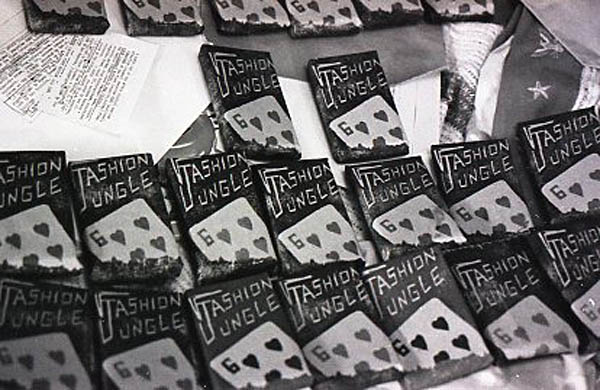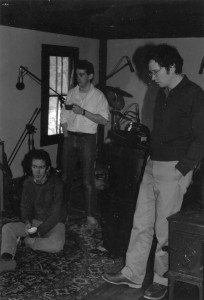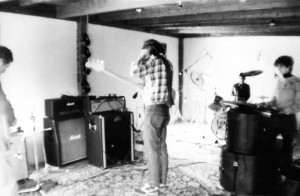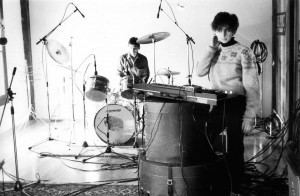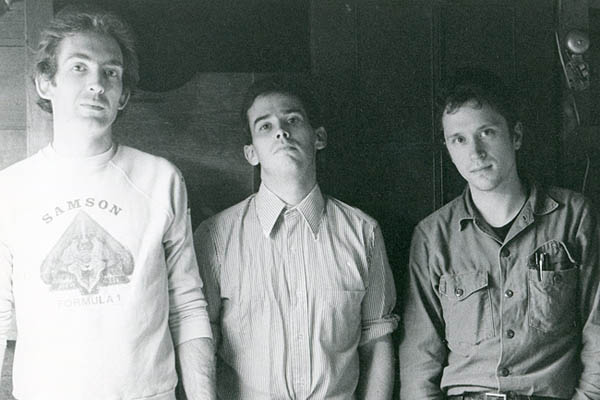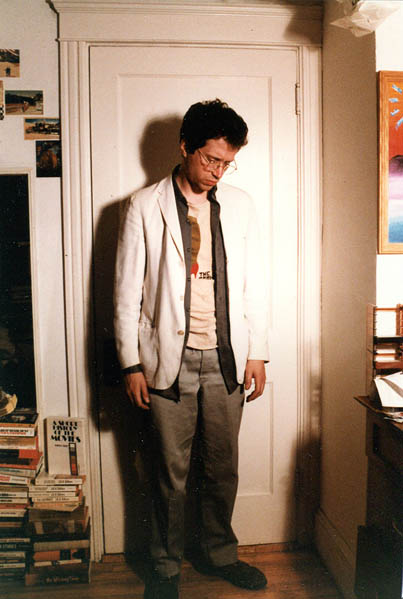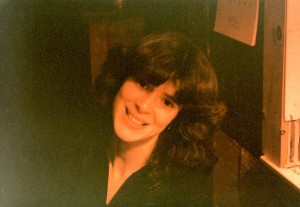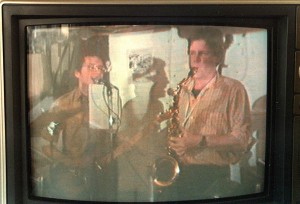Six Songs: Fashion Jungle in Studio, Part II
“It’s almost uncanny how some wishes get answered. Just last issue I suggested that the Fashion Jungle should get some of their songs captured in the studio, and next thing you know I’m handed a six-song tape. . . . [The FJ makes] not just rock and roll; it’s rock and roll with a little more. These are the best ‘new wave’ [sic] songsters in the state.
“Two criticisms, though. Sound quality is murky for a product for sale. And these guys still don’t know how to market themselves.” — Seth Berner, “More Sweets From the Street,” Sweet Potato magazine, Aug. 15-29, 1984
Where other bands go on the road for weeks and months, jammed into a van, breathing each other’s sweat and booze fumes, couch surfing and accumulating laundry like it was road miles, the Fashion Jungle spent just a couple of nights together away from home.
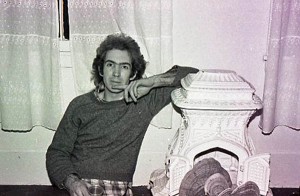
Steve Chapman at the Outlook during the “Six Songs” sessions, January 1984. Steve’s songwriting hit a new excellence on this project. Digital scan from black & white negative/Hubley Archives.
But, like the endless touring upon which most bands build a career, the result was a focus for our musical aspirations: a six-song cassette that would, we hoped, at best help us break out of the Portland scene and, at worst, earn us a few bucks.
Gee, whatever happened to those few bucks?
In the early winter of 1984, we holed up at a studio in Bethel, Maine, for our third stab at recording. The Outlook was run by Ted and Connie St. Pierre, a friendly couple who not only recorded musicians but put them up in a big old white-painted farmstead a few miles outside of town.
The former living room was the studio, and the control room was in an adjacent parlor or dining room. As you would expect, it was spacious, drafty and just what the doctor ordered for atmosphere.
I wish I remembered more about the actual sessions, because, I really must say, the recordings indicate that we played great. But it could have been Sergeant Pepper or the 1927 RCA sessions in Bristol, Tenn., and nevertheless what my memory would wrap in tissue and store in the vault of precious moments would still mostly involve . . . food.
For instance. Gretchen and I arrived at the Outlook first, late on a Friday morning, my sainted VW Squareback loaded to the roof with gear. We loaded in and then, priorities being what they are, drove back to town for lunch, enjoying a fine meal in what I recall was a greenhouse-like area in a welcoming restaurant. We were happy with our meal and also about being together at the start of this musical adventure, which seemed the furthest yet I was venturing toward the “real world” of professional music.
The glow was dimmed a little upon our return, as we found the other members of the band — bassist Steve Chapman, drummer Ken Reynolds and keyboardist Kathren Torraca — waiting for us impatiently. But no regrets, because that was our last good meal for two days.
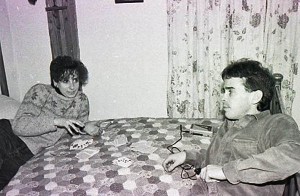
Kathren, at left, and Ken relax over cards during the January 1984 recording weekend at the Outlook. Digital scan from black & white negative/Hubley Archives.
In the arrangement with the studio, meals were included. And what meals! The St. Pierres didn’t eat meat, but neither were they vegetarians, because they apparently didn’t eat fruits or vegetables, either. “Mostly starchy white food was presented,” Ken recalls.
“I remember you and Gretchen going out to search for fruit,” specifically a bag of apples, “to augment the constant carbohydrate barrage provided by our hosts.” By the evening of Saturday, our one full day at the Outlook, we were desperate to eat something that wasn’t white paste.
As I recall, we laid down tracks during the day Friday and Saturday, and did overdubs into the evening Saturday — I still have a mental picture of Steve on a sofa putting the acoustic guitar onto “Final Words.” My other stray memories include recording the vocals for “Peacetime Hero,” and feeling very excited about the creepiness of them; asking Kathren to put the broken piano into “Nothing to Say”; and trying to get a decent guitar solo for that same song. Once I did, it ended up being the solo forever after.
See galleries from the Outlook sessions. Text continues below.
I’m guessing we stayed up late both nights to decompress and experience this unusual communal time. Aided by the images presented with this post (which I shot but never printed), I do remember a bit about the evenings. Kathren had a Walkman (the first I had heard of such a thing), and spent a lot of time absorbed in that. She and Ken played some cards on one of the big old beds in the farmhouse. Gretchen and I had brought my Trav-L-Bar and we put that to good use.
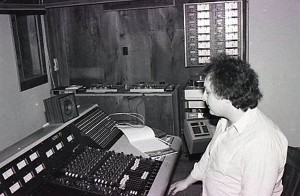
Ted St. Pierre, owner-engineer of the Outlook, at the desk. Digital scan from black & white negative/Hubley Archives.
We returned to Bethel to mix the tracks a few weeks after the recording sessions. As Ken recalls, engineer Ted St. Pierre “took a hands-off approach to recording, and I guess the reason was he thought we knew our music better than he did. So he left us to our own creative devices.I don’t remember him offering too many suggestions.”
Ted, a metal and hard-rock guy, would have mixed if we’d asked, I think, but he also encouraged us to do it ourselves. I was gaga for the idea, and I boldly led the way as we took our excellent tracks and submerged them in a sonic murk that severely weakened Six Songs and, I suspect, everyone’s excitement about it. (The recordings here, remastered decades later, are extremely listenable.)
And yet we never asked Ted to remix it or have us back to fix it; whether because of money, of which none of us had any to spare, or what, I don’t know. We had the idea of packaging the cassettes in a woodcut print, which Gretchen designed and printed by hand for the 50 or so copies we ordered. I used my trusty Smith Corona portable typewriter to make liner notes that we stuck on the cassette cases themselves.
I still remember Gretchen and I, and maybe other members of the FJ, spending evenings in her attic apartment in South Portland wrapping copies of Six Songs. We sealed each package with a sticky red dot that Gretchen numbered for each print. I have a piece of cardboard, part of the box the tapes came in, that lists where each copy of the tape went.
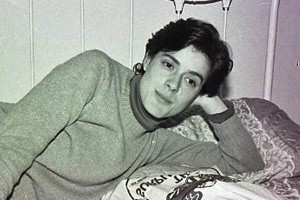
Fashion Jungle roadie and staff artist Gretchen Schaefer relaxing at the Outlook. Digital scan from black & white negative/Hubley Archives.
We sold a few copies retail, through the Record Exchange at the foot of Exchange Street and through a TV shop at Westgate that also sold music. And I gave quite a few away — to friends of the band and to visiting famous musicians, such as Richard Thompson and the McGarrigle Sisters, with whom I came in contact through my growing career as a music writer for the Guy Gannett newspapers. I had new copies still in the original box into the 1990s.
Mixing and packaging aside, I’m glad I don’t remember much about the actual recording process, because I think that means the sessions went well. In search of more information about our playing music together, though, I looked at my journal from 1984 this morning (Sept. 23, 2012). I’m kind of sorry I did.
There was nothing about the Bethel weekend, but there was ample evidence of my self-absorption and immaturity — and, more germane to this article, evidence of the bad timing and conflicting goals, primarily personal, that ultimately fractured the Chapman-Torraca lineup of the FJ. Ken was facing graduation from the University of Southern Maine in a few months, had already started working at the post office as a temp (which severely restricted his availability for rehearsal) and was worried about a career.
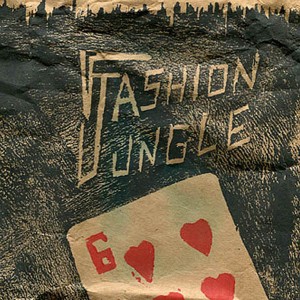
A detail of the woodcut print that Gretchen made for the “Six Songs” package. Courtesy of Schaefer Studio.
Steve was bored with making soup at a Portland restaurant and considering an education in computer work, which increasingly took him to Boston. And Kathren, still in her late teens, was restless. At worst, she considered quitting the FJ altogether; at best, she talked about taking a break and visiting Europe. Which, as it happened, she did.
These eddies and currents gained intensity as the year wore on. Things kept happening, from a cyst that sidelined me for a few weeks to Kathren’s Grand Tour to a rehearsal schedule that became increasingly erratic and non-productive. The songwriting pretty much stopped. But nevertheless, Six Songs was out there. And Portland, weirdly, was paying attention.
O clarity! O passion! The Fashion Jungle’s Six Songs, presented for your listening pleasure in newly bright and impactful versions, thanks to the miracle of learning how to use technology. Recorded in January 1984 at the Outlook, Bethel, Maine. Remastered in 2005 and 2012.
- End of the Affair (Hubley) The Chapman-Torraca Fashion Jungle presents a number dating back to the last days of the original FJ. The lyric draws on memories of a breakup in 1980, but the song is much more interesting than the real thing. I started the lyrics during a Labor Day 1981 getaway at the Grey Havens Inn in Georgetown, Maine.
- Curious Attraction (Chapman) One of the very best Fashion Jungle songs, this funky sci-fi love song was written and sung by bassist Steve. It gave Ken his long-awaited opportunity to emulate Charlie Watts in “Miss You.”
- Peacetime Hero (Sullivan) One of two songs that Jim Sullivan wrote for the original Fashion Jungle in 1981, inspired by the reintroduction of capital punishment. This excellent narrative stayed with the FJ from start to finish.
- Pleasures of the Flesh (Reynolds-Hubley) Ken sings his lyric about a “friends with benefits” arrangement that ultimately produces neither benefits nor friendship. I composed the tune for our second and last songwriting collaboration.
- Final Words (Chapman) Roaming through time and space on a sublime romantic journey, Steve’s second Six Songs contribution adds a stunning new dimension, as well as some lofty drama in a band known for such, to the FJ catalog. And Kathren’s keyboards are a perfect complement to the lyrics.
- Nothing to Say (Hubley) . . . and it takes me five minutes to say it. Not content to dwell on my own perceived inadequacies as a songwriter, I also took issue with the New Wave mega-sellout of the mid-’80s.
- Nothing to Say Demo (Hubley) Around 1983 I developed the habit, which I still have, of settling into a bar to write song lyrics. The booze helps, but the decisive elements are the neutrality of the setting and the random stimuli. So it’s interesting enough to keep my brain ticking over, but there’s nothing for me to get involved with besides the song. I wrote this complaint at Carbur’s, a restaurant and bar on Middle Street, in Portland. Here’s the demo I recorded for the band to learn it from.
“End of the Affair” and “Nothing to Say” copyright © 1984 by Douglas L. Hubley. “Curious Attraction” and “Final Words” copyright © 1984 by Stephen Chapman. “Peacetime Hero” copyright © 1981 by James Sullivan. “Pleasures of the Flesh” copyright © 1984 by Kenneth W. Reynolds and Douglas L. Hubley.
Text copyright © 2012 by Douglas L. Hubley. All rights reserved.
